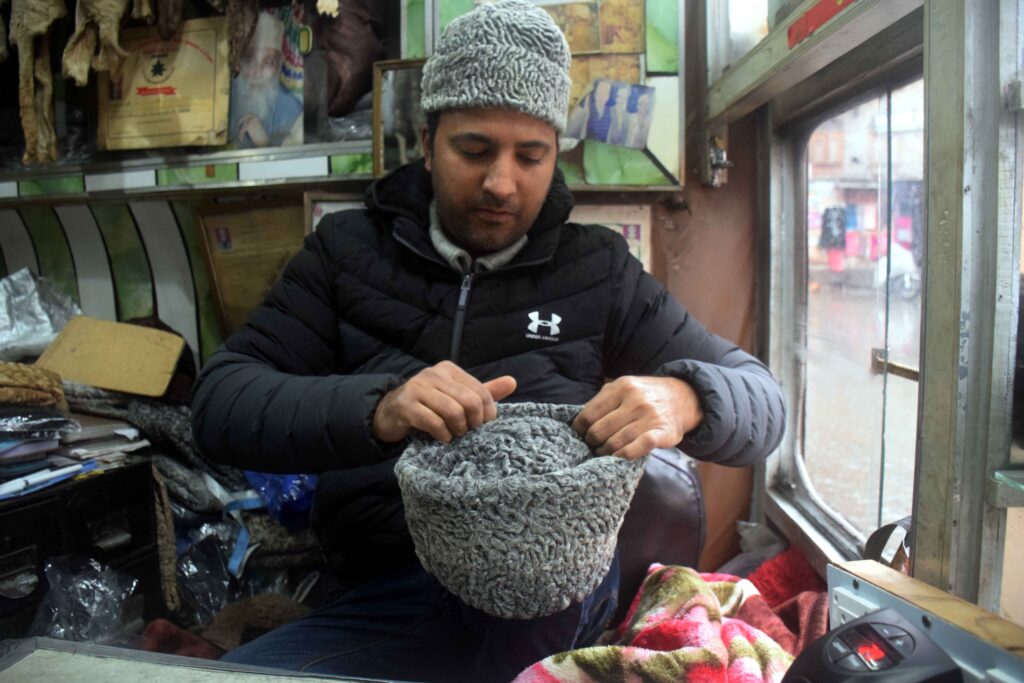Karakuli fur has a soft, curly texture, velvety feel and sheen – qualities that make the cap a prized possession.
Jaspreet Kaur
Men have been sporting headgear – hats, caps, turbans – since ages as a status symbol. In many cultures around the world, leaving your home without wearing a headgear was considered improper.
The karakul holds a very special place among caps and hats as far as its history and significance as a symbol of power, position or affluence is concerned.
History
The karakul cap is typically worn by men in Central and South Asia. It was worn by Amanullah Khan, the former king of Afghanistan, and Muhammad Ali Jinnah, the founder of Pakistan. The hat is peaked and folds flat when taken off of the wearer’s head.
The karakul hat, sometimes spelled as ‘qarakul’, also known as the Uzbek hat and Jinnah cap, is made from the fur of the qarakul breed of sheep. The karakul is native to Central Asia and is named after village Karakul which lies in the valley of the Amu Darja river in the former emirate of Bokhara, West Turkestan. This region is one of high altitude with scant desert vegetation and a limited water supply. A hard life imparted to the breed hardiness and ability to thrive under adverse conditions, which is distinctive of the karakul sheep to this day.
Some archaeological evidence points to karakul sheep being raised there since 1400 BC and carvings of a distinct karakul type have been found on ancient Babylonian temples.
Many adults have a double coat, a fine down undercoat, covered by a coat of guard hair. The best have a fleece as glossy as their lamb coat. But there is a great variability in the fleece type of both coats, from coarse to silky soft. It is easily spun, with little preparation. It produces a superior carpet yam, is often used for rugs and saddle blankets, outer garments and wall hangings, and has an excellent felting ability. This is the wool from which the art of felting evolved.
The karakul is distinguished by its colored fleece, which is due to a dominant black gene. The fleece is seen in a variety of natural colors. In its native region, the colors are called by various names: arabi (black), guligas (pink-roan), kambar (brown), shirazi (grey) and sur (agouti).
‘Karakul’ directly translates to ‘black fur’ in the Uzbek language. Most lambs are born coal black with lustrous wavy curls, with the face, ears, and legs usually showing smooth, sleek hair. As the lamb grows, the curls open and lose their pattern, and the colour generally begins to turn brownish or grey.

Very young or even foetal karakul lambs are prized for pelts. Newborn sheep pelts are called karakul (also spelled ‘caracul’), swakara (South West Africa Karakul), astrakhan (Russian and French), Persian lamb, agnello di Persia (Italian), krimmer (Russian) and garaköli bagana (Turkish). The newborn lambs have a tight, curly pattern of hair. The lambs must be under three days old when they are killed, or they will lose their black color and soft, tightly wound coils of fur. Foetal karakul lambs are harvested through miscarriages, induced early delivery or by killing the mother sheep and removing the foetus. People use the lamb pelts to create various clothing items, such as the astrakhan or karakul hat. The pelts have also been used in haute couture.
In the erstwhile Soviet Union, the karakul hat became very popular among politburo members. It became common that Soviet leaders appeared in public, wearing this type of hat. The hat probably gained its prestige among party leaders because it was an obligatory parade attribute of the Tsar and the Soviet generals.
Karakul caps became popular among Africans and African-Americans in the 1960s. African Presidents such as Modibo Keïta of Mali and Ahmed Sékou Touré of Guinea wore it.
Both the velvet and faux fur versions are worn by men, even with the traditional African attire such as the grand boubou, a wide sleeved robe. Muslims of African ancestry wear these caps with the dishdasha (ankle length robe). When worn properly, these caps are always slanted at an angle and never placed straight on the head. In popular culture, Eddie Murphy wore the karakul cap in Coming to America.
Kashmiri Karakuli
Karakul caps have been worn by Kashmiris for the past several decades and are known as karakuli. The traditional headgear in Kashmir historically was the turban tied in a similar fashion to the Pashtun turban. The karakuli is popular among most of the politicians. It has an important role to play in Kashmiri weddings where the bride’s family gifts it to the groom.
Muzaffar Ahmad Jan, 39, of Nawa Bazar’s Jan Cap House says his forefathers played an important role in making it famous worldwide, especially the Regal cap. Jan designed a karakuli for Narender Modi in 2014 and also for Late Arun Jaitley who was a finance minister in Modi’s cabinet. He has designed it for almost all prominent political leaders of Kashmir. Farooq Abdullah, Mirwaiz Farooq and former governors of Kashmir have worn caps designed by Jan. “I also designed 15 karakulis for the king of Oman, Qaboos bin Said al Said,” says Jan.
Fourth generation karakuli maker, Jan learnt the craft from his grandfather Ghulam Mohammed Jan, who had designed one for Mohammad Ali Jinnah, and his father who made karakulis for Rajiv Gandhi and Lalu Yadav.
“There are three fundamental styles of the cap,” explains Jan. The first is the Jinnah style, popularized by Pakistan’s founding father, Mohammad Ali Jinnah. Then there is the Afghan karakul style. The third style is the Russian karakul.
Hilal Ahmad from Nowhata area of Srinagar also learnt the art of making karakuli from his maternal grandfather and has been making these for decades.
Riyaz Ahmad Shah (55), another cap maker from the same area, and his family have been associated with karakuli making for almost a century.
Karakuli fur has a soft, curly texture, velvety feel and sheen – qualities that make it a prized possession. A karakuli costs anywhere from Rs 5,000 to Rs 25,000, depending on the quality of the skin.
Jaspreet Kaur is a Delhi-based architect, urban designer, Trustee Lymewoods & Span Foundation and Consulting editor of Kashmir Newsline.
(Follow @KashmirNewsline on Twitter.)


